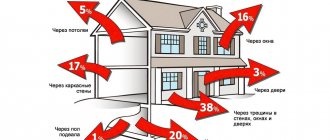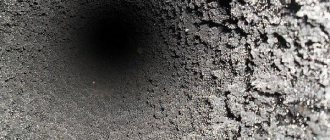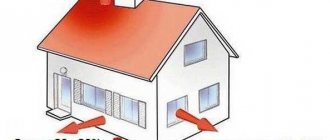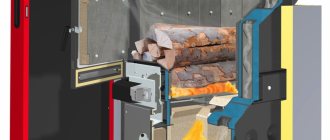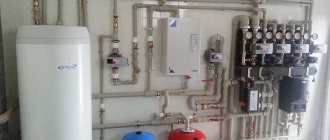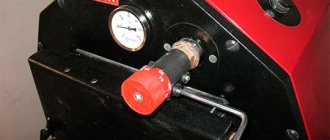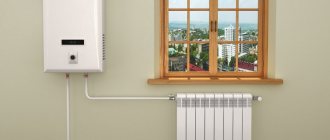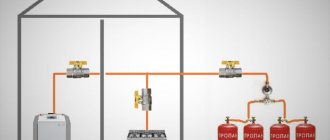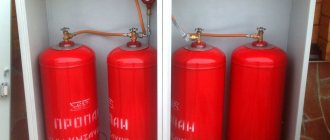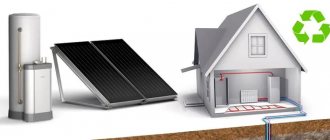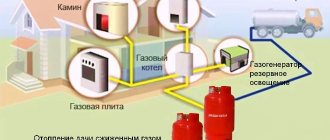Between November and April, in much of our country, the cost of heating a home often exceeds other utility bills. Therefore, even at the stage of designing a home, it is necessary to determine the most economical method of heating a private house. The choice may vary depending on the availability of connection to centralized gas and electricity supply networks, as well as energy prices.
When calculating the total cost of heating, take into account:
- network connection costs;
- the cost of equipment, materials and installation of the heating system;
- energy price;
- depreciation expenses.
Indirect costs, for example, for the construction of a firewood or coal storage facility are included in the cost of utility premises.
Residential heating options
The well-known and most common way to heat your own house or apartment is to make a water system. Operating principle: the coolant is heated by a boiler or other source, then transferred through pipes to heating devices - radiators, heated floors (abbreviated as TP) or baseboard heaters.
Note. Water heating is used in 99% of apartment buildings and administrative buildings. There are 2 methods of supplying coolant - from a centralized city network or from an individual boiler house serving a specific building.
A heat exchanger placed inside the stove heats the water, directed by the pump to the batteries.
Now we list alternative heating options:
- Stove. A metal potbelly stove is installed or a full-fledged brick oven is built. If desired, a water circuit is built into the firebox or smoke channels of the stove (shown in the photo above).
- Purely electric - convectors, infrared and oil heaters, spiral fan heaters. A more modern method is to install underfloor heating using resistive cables or polymer film. The latter is called infrared, carbon.
- Air. The heat source warms up the filtered street air, which is forced into the rooms by a powerful fan. A simpler and cheaper option is to install gas convectors in residential premises.
- Combined - wood stove + electric heaters of any type.
Scheme for heating a bathroom with electric heated floors
To move on, you need to decide which type of heating is better - more profitable, more efficient, more convenient. We definitely recommend choosing a water system. Causes:
- to heat water, you can use any energy source or combine several types of fuel by installing 2-3 boilers;
- if there are high requirements for interior design, the piping is installed in a hidden way, instead of batteries, baseboard heaters or TP circuits are used;
- the ability to organize hot water supply (DHW) - install a double-circuit boiler or an indirect heating boiler (depending on the amount of water consumed);
- Alternative energy sources can be connected to the system - solar collectors, heat pump;
- if necessary, heating in a private house is made completely autonomous - pipes are laid according to a gravity (gravity) scheme, plus a boiler unit is installed that does not require connection to the electrical network;
- The system lends itself well to adjustment, automation and remote control via cellular communications or the Internet.
The only drawback of water networks is the cost of installation, equipment and shut-off and control valves. The purchase and connection of electric heaters will be cheaper, but restrictions in terms of fuel choice will lead to increased operating costs.
Construction of a brick kiln is an expensive and labor-intensive undertaking. An affordable iron potbelly stove will heat 2-3 adjacent rooms, so it is only suitable for a summer house or a change house.
Installing full-fledged air heating in a country cottage will cost even more than building a stove. It is necessary to purchase a ventilation unit with a recuperator, which plays the role of a blower, purifier and air heater. Then organize supply and exhaust - run air ducts to all rooms. An expert will talk about the pitfalls of air heating in the video:
Solid fuel
Coal.
Solid fuels include:
- wood;
- different types of coal;
- waste from wood processing and agricultural enterprises.
Solid fuel is burned to produce heat. Direct heating does not imply the use of an intermediate coolant; in the case of installing solid fuel boilers, heating systems with radiators are installed.
Stoves, fireplaces, potbelly stoves
It is advisable to consider stoves as the main heating system when building rarely visited country houses or bathhouses.
| Advantages | Flaws |
| Minimum equipment price | Rapid fuel burnout |
| Instant heat release from steel stoves and fireplaces after ignition | High cost of stone stoves |
| Long heating of brick or stone walls | |
| Low efficiency: 30% for potbelly stoves, 60% for the best stove models | |
| The need to arrange fuel storage areas | |
| Fire hazard of stoves and woodburners | |
| Danger of carbon monoxide poisoning | |
| Heating no more than 2-3 rooms |
The best options for heating stoves are of the bell-type type, when hot air passes several times through the smoke channels and is collected under a kind of hood.
Bell type furnace.
Steel stoves are chosen based on the same criteria: the gases must burn completely after passing through several smoke channels.
Solid fuel boilers with manual operation
Cutaway view of a modern Teplodar Kupper coal boiler.
The use of wood or coal boilers is recommended in areas where it is impossible to connect to a centralized gas supply or where it is not possible to equip a gas holder.
Table. Advantages and disadvantages of heating with wood and coal boilers.
| Advantages | Flaws |
| Fuel of any quality is suitable | Instability of calorific value - depends on the moisture content of the fuel, type of coal, type of wood, difficulty in calculating the fuel required for the season |
| Complete independence from power supply when installing a gravity system | Requires constant monitoring and maintenance - loading fuel, removing ash |
| Low price of 1 kW of energy | Low average efficiency |
| Possibility to use free or cheap wood processing waste (often wane can be removed for free, paying only for transport services) | Cooling of radiators with high hot water consumption (in double-circuit boilers) |
| Availability of automated boilers with adjustable combustion speed and supply of pallets or granules | Fire hazard in fuel storage areas |
| Difficulties in organizing a “warm floor” system |
The price of the most popular boilers with a capacity of 14-20 kW ranges from 25 to 70 thousand rubles.
Advice! To maintain the temperature of the coolant at night and during the day, when the owners are absent, they purchase boilers with built-in electric heating elements, which turn on when the fuel burns out and the temperature drops.
Justification for the purchase of high-tech solid fuel boilers
In an effort to increase efficiency, manufacturers resort to various technical solutions:
- create conditions for complete combustion of fuel;
- air charging fans are built into the design to ensure fast or slow combustion;
- install automatic dampers that reduce the air supply when the coolant is overheated.
This is what a pre-installed air charge fan looks like.
Automatic damper on a TT boiler.
Pyrolysis is the separation from fuel by heating it of gases that burn at high temperatures. The process requires precise stabilization of the operating mode.
The operating principle of pyrolysis coal boilers using the Geyser VP model as an example.
It is technologically difficult to achieve the effect in boilers less than 50 kW, but this power is enough to heat a house up to 500 m2.
The offered boilers up to 50 kW can only conditionally be called pyrolysis. Usually these are two-chamber devices. In the first chamber, direct combustion of wood (coal) occurs, and the second is an afterburning chamber, where the remaining organic substances are burned.
The price of such boilers is 2-3 times higher than usual, so part of the profit received by the manufacturer can be used for advertising.
Important! The purchase of so-called “pyrolysis” boilers of low power (up to 40 kW) allows you to increase the efficiency of installations by 5-20%, but you will have to pay 2.5-3 times the cost for the equipment.
In order to talk about the payback of high-tech pyrolysis boilers relative to conventional ones (direct combustion), it is necessary to calculate the costs incurred.
Example. To heat the house, a 25 kW boiler is required. A direct combustion device costs about 35 thousand rubles, a “pyrolysis” device costs about 90 thousand.
For example, the consumption of firewood in a regular boiler per season will be about 20,000, in a “pyrolysis” boiler it is 5-10% less, i.e. 18–18.6 thousand rubles. The savings will be 1.4–2.0 thousand rubles. Boilers up to 25 kW must be equipped with a fan with a power of 50 W or more, which will consume 800–900 rubles worth of electricity per season. Thus, the net benefit from installing a long-burning boiler will be no more than 1000 rubles per season; we can talk about payback in 30-40 years.
Payback of truly pyrolysis boilers within 10-15 years of operation is possible with equipment power of 40 kW; in such devices, combustion efficiency can be increased by 20%.
Efficiency and selection criteria for modern pyrolysis solid fuel boilers
The best manufacturers of solid fuel boilers
Solid fuel boilers are produced by many brands. Based on the number of sales and user reviews, the following companies' products stand out:
- Teplodar;
- Rommer;
- TMF;
- Zota;
- Heiztechnik;
- Thermocraft.
The choice is made according to the required power and available fuel.
Choosing an energy carrier
The main selection criterion is the cost of energy, depending on the country and region of residence. If in the Russian Federation the undoubted leader is natural gas, then in the rest of the states of the former USSR the picture is different - firewood, briquettes and coal take the first place. Don't forget about electricity supplied at half the nightly rate.
When choosing the right type of fuel, it is worth considering five factors (in addition to price):
- efficiency (efficiency) of heating equipment using this energy carrier;
- ease of use;
- how often the units will have to be serviced, prices for calling a technician;
- storage requirements.
Below is a comparative table showing the prices of various energy sources and how much a kilowatt of heat produced in real conditions costs. Building area – 100 m², region – Moscow region.
Note. The calculation results and prices are given as of February 15, 2018. Over time, the data becomes irrelevant, but the difference in the cost of 1 kW remains.
Based on the numbers given in the table, it is much easier to find a suitable option (or several). Just make an adjustment for the cost of energy in your region. Based on other selection criteria, we will give 4 tips:
- It is most convenient to use gas and electric heating equipment. There is no need to store anything, constantly maintain and bother with cleaning water heating devices.
- Burning coal and wood is the most economical way to heat. Saving money will have to be paid for with labor - sawing, carrying, loading the firebox, cleaning the chimney. It is more comfortable to burn briquettes and pellets, but the price of the boiler installation and the fuel itself increases. Plus you will need storage for storage.
- Diesel fuel or liquefied gas is the best solution for providing autonomous and at the same time comfortable heating when other energy sources are not available. The downside is the decent cost of fuel and installation of the fuel tank.
- A proven option is the combination of 2-3 energy carriers. A common example: solid fuel + electricity at night tariff.
Which fuel is best to use in specific conditions is described in detail in a separate material. We also recommend watching the video and listening to useful expert advice:
What type of fuel can be called the most accessible and cheapest?
A dispute often arises as to which fuel is the cheapest in the absence of mains gas. We are looking for the cheapest heating without gas based on the experience of our forum users.
ArtashirFORUMHOUSE user
I decided to make an approximate calculation of the costs of operating different types of heating equipment over a period of 15 years, including the cost of energy, for the following heating systems:
- gas (gas boiler);
- heating with wood;
- heating using wood pellets;
- electric (electric boiler).
The forum member used the following as initial data:
- Residential building area - 100 sq.m;
- The duration of the heating period is 8 months;
- The average power of equipment during the heating period (efficiency) is 50%;
- Specific power of the climatic zone is 1.5 kW (Khanty-Mansiysk Autonomous Okrug - Yugra).
Hot water supply and gas stove are not taken into account in the calculations.
And this is what happened.
As can be seen from the tables presented, the most expensive heating is electricity at a daily rate. The cheapest is main gas, solid fuel is in the middle of this rating. It is also necessary to familiarize yourself with the results of a similar calculation by a user of our site under the nickname bkostik.
BkostikFORUMHOUSE user
I made calculations in relation to St. Petersburg.
As can be seen from the table, heating with diesel fuel and bottled gas is one of the most expensive, but heating with electricity, when using the night tariff, is not so expensive. However, this does not mean that everyone can install an electric boiler for themselves, because... Not in all settlements the required power can be allocated to a house. In order for heating a house without gas, with electricity alone, to be truly profitable, a number of conditions must be met. Namely:
The house must be well insulated;
- Heat loss through building envelopes (walls, floors, roofs) as well as windows and doors should be minimized;
- A heat accumulator is required.
Schemes of water heating systems
We are moving on to the next step - developing a project for the future system, according to which we will purchase materials, fittings and thermal power equipment. The task is to choose the appropriate type of wiring, apply pipes to the layout of a private house, and arrange heating appliances.
Reservation. It is assumed that a place has already been allocated for installation of the heat generator - a furnace room, an extension, a kitchen or a corridor. We outlined the regulatory requirements for the placement of boilers in detail in another publication.
To deliver heated water to appliances and transfer heat to the air in rooms, the following schemes are used:
- single-pipe - horizontal “Leningrad” or riser system;
- two-pipe - dead-end, collector, associated ring (otherwise - Tichelman loop);
- water circuits for underfloor heating - heated floors (HF).
The first 2 types of wiring work in conjunction with radiators or other heating devices. The coolant movement is ensured in two ways:
- Forced, using an electric pump installed on the main pipeline or directly in the boiler.
- Natural circulation of water through the pipes (gravity flow) due to the difference in temperature and mass of the coolant between the supply and return lines. Cold liquid is heavier, so it tends to push hot liquid upward.
A gravity riser system with an overhead coolant distribution is suitable for a two-story house.
In the first case, the system does not communicate with the atmosphere and operates with an excess pressure of 0.6...3 Bar, depending on the degree of heating and the initial pressure in the network. The resulting excess expanding water is absorbed by a closed tank with a rubber membrane inside.
The gravity circuit is in contact with the atmosphere through an expansion tank located at the highest point of the system. In this way, airing is prevented - the bubbles formed in the pipes and batteries rise and go into the open tank. Effective air removal is facilitated by slopes of horizontal sections.
Let us consider each option separately and for clarity, we will give examples of typical schemes.
Single-pipe wiring - pros and cons
The supply and return of coolant in this system is organized through a single looped pipe. Accordingly, each radiator is connected to the main line using both connections. In the Leningrad scheme, this collector is laid horizontally, while the riser is laid vertically.
On the left is the connection of the radiator to the vertical riser, on the right - according to the Leningrad horizontal scheme
Negative aspects of single-pipe coolant distribution:
- due to the addition of cooled water, the temperature of the main line decreases by 1-2 °C after each battery;
- in order to ensure the required coolant flow in heating devices, the diameter of the main pipeline must be at least 25 mm throughout its entire length;
- when the number of radiators is more than 5 pieces, the cross-section of the collector increases to 32 mm;
- the last batteries receive cooled coolant, so they heat worse, the problem is solved by increasing the number of sections or increasing the size of the panels by 10%;
- “thanks to” the increased diameter of the line and the expansion of radiators, the costs of materials increase.
Note. The disadvantages of the Leningradka are listed here; with vertical wiring, the disadvantages are not so critical. There the problem is different - the risers that penetrate the ceilings are not easy to wall up inside the walls, the pipes stick out in plain sight. More details here: description of single-pipe heating networks.
Classic "Leningradka" closed type with a gas boiler
Positive points:
- Simplified installation - one pipe is easier to install than two.
- The Leningrad heating system for a private house, assembled from polypropylene pipes, is the most budget option. But if you use metal-plastic or cross-linked polyethylene, this advantage is offset by the price of the fittings.
- Single-pipe vertical risers are the best solution when installing a gravity system in a two-story house.
Taking into account the peculiarities of single-pipe schemes and the lack of installation experience of most homeowners, we recommend assembling the “Leningradka” in small country houses or residential buildings. If you want to save money, use polypropylene plus inexpensive steel radiators.
Methods for two-pipe battery connection
The main difference between these systems and single-pipe systems is the separate supply of coolant to the devices - hot water comes to the batteries through one line and returns through another. When installing heating, 3 types of schemes are used:
- Classic deadlock (shoulder). The coolant is supplied to the battery group, then moves back through the return pipeline. If necessary, the system is divided into several dead-end branches, and hydraulic equilibrium is established between them due to balancing. Two-pipe dead-end wiring with 4 branches for a two-story cottage
- Ring distribution with a parallel flow of forward and reverse water. The two-pipe loop is assembled in such a way that the coolant leaving the radiator does not change the direction of movement. The first heater on the supply line is the last on the return line and vice versa.
In a two-story building, 2 Tichelman loops are laid out, connected to a common riser - The collector circuit provides for individual connection of each battery to a common distribution comb, powered from the boiler.
Each floor will need its own distribution manifold
Important point. The main advantage of two-pipe networks is the supply of water at the same temperature to all radiators. Hence the other advantages - distribution pipes of smaller diameter (15-20 mm), normal battery sizes and no restrictions on the number of devices.
A novice developer installing heating with his own hands for the first time is recommended to choose the first option - shoulder wiring. It is simple and reliable, and the most affordable. A preliminary design for a one-story house is developed as follows:
- Mark the windows on the building plan and place radiators near these openings. If there is no glazing, the device is placed near the coldest outer wall.
- Place a heater on the drawing - a boiler, a furnace with a water heating circuit, a heat pump.
- Run along the outer walls from the boiler pipe to the radiators. To avoid crossing the doorway, divide the net into 2 arms of approximately the same length.
- If there is a second floor, make 1-2 additional branches laid upstairs. It is better to lift the second floor branch directly from the boiler room.
An example of a heating project for a one-story building with an area of 100 square meters.
Pipe diameters for a building of 100...200 m² (closed system): from the boiler - DN20, arms (branches) - DN15, connections to the heaters - DN10. The indicated sections are taken from practice; there is no need to calculate water flow and hydraulics. The exception is houses of complex configuration, large number of floors and area.
Reference. The designation “Du” indicates the diameter of the internal passage in millimeters (rounded). For example, the diameter of a plastic pipe 26 x 2 mm is 20 mm.
It is convenient to make a collector system during the construction process - the connections to the batteries are hidden in the floors. The Tichelman loop helps out in a situation where you need to “plant” 10...20 radiators on 1 line. On our resource there is a separate material devoted to the consideration of two-pipe wiring methods.
About underfloor heating circuits
The advantages of water heating over other heating methods are obvious:
- uniform heating of the room, starting from the lower zone;
- efficiency - due to lower water temperature (35...55 degrees versus 60...80 °C on batteries);
- aesthetics - heaters and pipelines are not visible;
- convenient regulation using automation - distribution manifold servo drives and room temperature sensors.
Along with the impressive advantages, we note the main disadvantage of TP - the high costs of purchasing materials and installation. The circuits will require a decent amount of quality pipe (metal-plastic, copper, cross-linked polyethylene), a manifold with flow meters and a mixing unit. Add the layout of the hinges and the installation of a cement floor screed - a considerable number will come out.
Advice on reducing the cost of construction. In a country house or apartment up to 150 m², you can save on the purchase of a manifold and mixing unit - make a TP comb yourself from the tees, and install RTL thermal heads to limit the temperature of the coolant.
Minor disadvantages of floor contours:
- Inertia. When heated, the concrete monolith absorbs a lot of heat, which continues to be released after the heating is turned off. And vice versa, “overclocking” cooled TP takes 4...6 hours.
- If a pipe breaks inside the screed, repair is very difficult. It’s unlikely to do without calling the experts, because you need to find the defect, open the monolith and properly fix the leak.
- A power supply failure in an apartment building is a real problem. You will have to repair your own home plus your neighbor’s flooded one (from the bottom floor).
An example of a TP layout on the first floor of a house.
The comb is located in the center of the building, large rooms are divided into 2 water circuits. The inertia of warm water floors is “overcome” with the help of traditional radiators that quickly respond to changes in the temperature of the boiler water. For ease of adjustment, 2 systems are installed - TP and batteries, which is not cheap. How to independently arrange heating heating circuits, read our other guide.
Single pipe systems
In single-pipe heating systems, the coolant passes sequentially through all radiators.
When creating heating for a private house with your own hands, the easiest way is to equip a single-pipe heating system. It has many advantages, such as cost-effective use of materials. Here we can save a lot on pipes and achieve heat delivery to every room. A single-pipe heating system provides for sequential delivery of coolant to each battery. That is, the coolant leaves the boiler, enters one battery, then another, then a third, and so on .
What happens in the last battery? Having reached the end of the heating system, the coolant turns around and is sent back to the boiler through a single pipe. What are the main advantages of such a scheme?
- Easy to install - you need to sequentially pass the coolant through the batteries and return it back.
- Minimum consumption of materials is the simplest and cheapest scheme.
- Low location of heating pipes - they can be mounted at floor level or completely lowered under the floors (this can increase the hydraulic resistance and require the use of a circulation pump).
There are also some disadvantages that you have to put up with:
- limited length of the horizontal section - no more than 30 meters;
- The farther from the boiler, the colder the radiators.
However, there are some technical tricks that can mitigate these shortcomings. For example, the length of horizontal sections can be dealt with by installing a circulation pump. It will also help make the last radiators warmer. Bypass jumpers on each radiator will also help compensate for the temperature drop. Let's now discuss certain types of single-pipe systems.
Equipment, components and materials
The next step after developing the scheme is the selection of all heating elements:
- heat generator;
- radiators, underfloor heating collector;
- pipes;
- expansion tank, circulation pump, fittings and heater piping parts.
Clarification. Wall-mounted gas boilers and some floor-standing models are equipped with a pump and expansion tank located inside the unit. If you plan to purchase such a device, still make sure that the tank volume is sufficient for your system.
Let’s immediately make a reservation that we will consider a hot water boiler as a heating unit. You will not be able to install an air or geothermal heat pump without the help of specialists, and connecting the water circuit of the stove is carried out in the same way as connecting a solid fuel heat generator.
How to calculate the capacity of the expansion tank, choose the right pump and fittings:
- The useful volume of the tank must be at least 10% of the total amount of coolant circulating in the heating network. The water jacket of the boiler is also considered.
- If the building area does not exceed 150 m², then circulation will be provided by a pump with 25/40 or 32/40. The first number is the diameter of the threaded connection, the second is the developed pressure. The 25/40 unit is equipped with a 1” pipe thread and is capable of delivering a pressure of 0.4 Bar.
The most common model of pumping unit 25/40 from the Grundfos brand - For a large cottage and floor circuits, it is better to select a pump according to the algorithm.
- Shut-off ball valves are installed in front of the heat generator, expansion tank, pumping unit and on the make-up pipe. Additional equipment - a buffer tank, an indirect heating tank, a solar system - must also be cut off by taps.
- Each heating radiator is equipped with a thermostatic valve at the inlet and a balancing valve at the outlet. In the unregulated version, a ball valve is installed on the battery supply pipe.
The final list of components is compiled after selecting the main elements - a thermal power plant, batteries and a pump with a tank. Accordingly, we will next consider the issue...
With forced and natural circulation
All the schemes presented above can be created on the basis of heating boilers of any type. For example, a stove heating scheme for a private house is built on the basis of a wood or coal stove, and pipe routing can be carried out according to almost any of the schemes described above. True, it would not hurt to add forced circulation to many of them. What is it for?
The main difference between a system with forced circulation of coolant and a system with natural circulation is the circulation pump.
As we remember, single-pipe heating systems are characterized by a decrease in coolant temperature as it moves away from the boiler - part of the heat remains in the radiators. These losses are partially compensated by the Leningradka scheme, but in some cases this is not enough. In order to correct the situation, a circulation pump is installed in the heating system, providing forced circulation of the coolant .
Forced circulation is also necessary in many other schemes, including two-pipe ones. The thing is that the small diameter of modern polypropylene pipes, numerous connections and turns create hydraulic resistance. In addition, the use of forced ventilation allows for faster heating of households.
Advantages and disadvantages of forced and natural circulation
Each system has its own advantages and disadvantages:
When heating a room with a large number of radiators, a circulation pump is simply necessary.
- natural circulation is simpler and cheaper - there are no costs for circulation pumps;
- forced circulation makes it possible to improve heating performance in large buildings - in some cases you can get by with natural circulation, but then the system warm-up time increases;
- forced circulation is characterized by a slight hum – natural circulation is completely silent.
That is, everything has its advantages and disadvantages.
How to choose a heating unit
Factors influencing the choice of a boiler (or several water heating devices):
- energy carrier used;
- heat generator power;
- dependence on external energy sources;
- price;
- functionality, ease of use.
Note. The heater selection criteria are arranged in order of priority. It is important for the user that the unit consumes cheap fuel and produces enough heat. Price plays a secondary role; comfort and functionality come in third place.
All household boilers are usually divided into groups according to the type of fuel (energy carrier) burned:
- gas;
- electrical;
- solid fuel;
- liquid fuel, consuming diesel fuel and waste oil;
- universal, operating on 2-3 types of energy carriers.
Each of the listed groups is divided into varieties according to the operating principle, installation method and other criteria. We will review existing boilers and give a number of useful recommendations.
Types of gas boilers
To organize heating in private homes, 3 types of units using natural gas are sold:
- Atmospheric. The combustion chamber is open, combustion air is taken from the boiler room. The operating efficiency is in the range of 86...88%.
- Supercharged (aka turbocharged). Air is forced into the closed firebox by a fan controlled by an electronic circuit. Boiler efficiency is 90...93%.
- Condensation. Structurally similar to turbocharged heaters, but the heat exchanger and burner are designed in such a way that in a certain mode the boiler uses the latent heat of combustion of the fuel. Efficiency – 95%.
Reference. All heat generators are capable of burning 2 types of fuel - natural gas and liquefied propane-butane mixture (LPG). To switch to LPG, the fuel jets are replaced and the automation is adjusted.
Boilers are manufactured in wall, floor and parapet versions. The first group is ready-made mini-boiler rooms, equipped with their own expansion tank and pump. The second type is high-power units, or those that do not depend on electricity. Parapet models are placed near the outer wall, the chimney goes directly to the street.
Among the large assortment of gas water heaters, it is not easy to make the right choice. Our recommendations are:
- If you are on a limited budget, purchase an atmospheric wall-mounted boiler. But remember - open-chamber heaters require a traditional chimney.
- To work together with the gravity system, you will need a non-volatile floor-mounted atmospheric unit.
Floor-mounted non-volatile heater equipped with a single-stage burner, mechanical automatic safety system EuroSIT and a cast iron heat exchanger - It is better to install a forced-air heat generator in an apartment or cottage without a ready-made chimney. Organize the removal of combustion products through a coaxial pipe laid through the outer wall.
- To supply hot water to 1-2 consumers, buy a dual-circuit model. If the consumption in the DHW network is high, you will need an indirect heating boiler connected to a conventional single-circuit heater.
- Read the detailed description of all gas heaters presented in a separate article.
A condensing boiler is the most economical among gas-using devices. The disadvantage of the unit is the complexity, high price of the equipment and its repair.
Electric hot water installations
A feature of electric boilers of any type is their high efficiency, reaching 99%. The second positive point is the low installation costs and purchase of the heaters themselves. The units should be used as auxiliary heat sources, operating at night at half the light tariff.
There are 3 types of electric boilers (all are available in wall-mounted versions):
- With traditional tubular heaters - heating elements. Modern devices are equipped with an expansion tank and a circulation pump.
- Electrode. Heating of the coolant occurs due to a chemical reaction resulting from the passage of current through the water layer between the 2 electrodes.
- Induction. Here the coolant is heated by the steel core of a sealed coil, which creates eddy currents in it.
Sectional view of a heat generator with tubular heaters (TEH)
To install electric heating, it is better to take a classic heating element boiler that does not require serious piping. The device is reliable and easy to repair - you can always replace a burnt heating element yourself. An induction heat generator is expensive and cannot be repaired in the event of a breakdown, and an electrode heat generator is highly dependent on the salt content in the coolant.
Advice. Don't listen to salespeople who call induction boilers energy-saving. All electrical installations heat water equally efficiently - losses do not exceed 2%, the rest of the energy is converted into heat.
Classification of solid fuel boilers
For heating country cottages, 3 types of solid fuel units are used:
- direct combustion - atmospheric and turbocharged;
- pyrolysis;
- automatic pellet and coal.
There are many myths about the efficiency of TT boilers. Manufacturers of pyrolysis heat generators claim an efficiency of 85-86%, pellet heat generators - up to 90%. In reality, the figures are much more modest: traditional wood-burning units - 75%, pyrolysis units - 75%, boilers using pellets and coal chips - up to 86%.
Construction of a direct combustion boiler with a fire tube heat exchanger
Reference. In addition to the listed types of heaters, there are long-burning TT boilers with an increased size of the firebox. How to distinguish such installations from classic wood-burning heat generators, read the corresponding publication.
Recommendations for choosing a solid fuel boiler:
- A steel direct combustion apparatus equipped with a chain draft regulator is perfect for burning wood, coal and briquettes. Turbocharged examples are automated and burn wood better, but rely on electricity.
- Pay attention to the volume of the firebox of a traditional boiler - the duration of combustion depends on this indicator.
- Automated pellet units are a good solution for lovers of comfortable heating. You don’t have to chop and carry wood, remove coal dust, just clean the firebox and burner weekly.
- Do not mess with pyrolysis TT boilers, they are a priori more expensive than conventional ones, demanding on the quality of fuel, and in addition they consume electricity.
- Avoid models with water-filled grates if you plan to burn with coal. The temperature difference forms a hard crust on the surface of the grate, which is not easy to knock off.
Grate of a TT boiler made of pipes filled with coolant
When choosing a heat generator, remember the old saying “the miser pays twice.” It is better to take a high-quality classic device with a cast-iron heat exchanger than a cheap “pellet generator” with electronics of unknown origin.
Diesel and combined models
This heating equipment is used much less frequently than gas, wood and electric boilers. Diesel fuel is more expensive than other energy sources, and waste oil is a specific fuel that is clearly unsuitable for the average homeowner. Accordingly, such heating devices are operated only in certain conditions when access to other resources is limited.
Multi-fuel boilers from different manufacturers combine 2-3 energy sources, for example, wood + electricity, gas + coal. Advantage: you buy one heat generator and get two. Disadvantage: the unit cannot boast of high efficiency and functionality. The most popular option is shown in the photo - a TT boiler, equipped with a heating element unit for electrically heating water after the flame in the firebox has died out.
Electric wood heater from the Russian company Teplodar
Heat generator power calculation
To select a boiler based on performance, you should find out the load on the heating system of the house. That is, calculate the heat losses of the building. We propose to calculate this indicator in a simplified way:
- If a living room is separated from the street by one wall with 1 window opening, then 0.1 kW of heat is consumed to heat a square meter of area.
- A room with two external walls (corner) and 1 window – 0.12 kW/m².
- The same, with 2 light openings - 0.13 kW/m².
An important nuance. The calculation is performed for each room separately, then the results are summed up.
The algorithm is suitable for buildings with floor heights up to 3 meters. If the ceilings are higher, heat consumption is calculated based on the volume of the room. Accordingly, in a room with 1 fence and a window, the volume value is 35 W/m³, in a corner room – 40 W/m³, in a corner room with two openings – 45 W/m³.
Having determined the need for thermal energy at home, we select the power of the boiler installation according to the instructions:
- The performance of a unit operating only for heating is taken with a margin of 20%. That is, we multiply the found amount of heat by a factor of 1.2.
- The heat generator providing hot water supply must be taken with a reserve of 50% (coefficient 1.5).
- For TT boilers, the increasing coefficients are 1.5 and 2, respectively.
If you live in an area with a mild southern climate, then the coefficients should not be used. Conversely, residents of the northern regions should increase the initial heat loss figure by 1.5-2 times.
Calculation of heat losses by volume of residential premises
Return on investment in reducing heat loss
All consumed heat leaves the house through building structures: floors, walls, ceilings, roofing and windows (doors).
A visual representation of heat loss in a private home.
You can understand how effective thermal insulation is by using heat loss calculators.
Example. A one-story house 6x6 m with a wall height of 3 meters made of expanded clay concrete blocks 40 cm thick, covered with a 20 cm concrete slab. The wall area will be 72 m2, the ceiling area will be 36 m2. The difference between the outside and room temperature is 40 °C (outdoors -20, indoors +20).
Without taking into account windows and doors, heat loss through building structures will be approximately 20 kW (8.7 through the walls and 12.2 through the ceiling).
If you insulate the walls with 100 mm thick polystyrene foam and the ceiling with 50 mm polystyrene foam, then the losses will be reduced to 3 kW (1.4 through the walls and 1.6 through the ceiling).
Even the most approximate calculations show that insulation with modern materials can reduce energy costs by more than 5-7 times.
Replacing one window with an area of 2 m2 with a wooden frame with a two-chamber one made of plastic gives an annual fuel saving of about 350 rubles. On average, it is believed that plastic windows pay for themselves in 8-10 years of operation. Already at the design stage, they plan the placement of rooms, windows and doors, taking into account the cardinal directions.
Conclusion: insulating a house reduces current heating costs several times. The insulation lasts up to 50 years, and the investment pays off in 2-4 years, which is much more effective than saving on the heating system.
Types of heating batteries
Water heating devices are divided into types based on the material they are made of:
- steel;
- aluminum;
- cast iron;
- bimetallic.
Construction of stamped steel heaters
Reference. The name “aluminum radiators” is conditional. In fact, batteries are made from an alloy of aluminum and silicon - silumin.
Steel radiators are available in the form of flat panels and individual sections connected by threaded nipples. Batteries made of cast iron, silumin, bimetal - sectional. The latter type of devices is also made of an alloy, but a frame made of iron pipes is inserted inside, withstanding high pressure and protecting the aluminum walls from corrosion.
Connecting a sectional battery with nipples
How to choose heating radiators:
- Select the type of batteries for a private home at your discretion; any will do - cast iron, iron, aluminum. Focus on your own budget, appearance, quality of products.
- In an apartment in a high-rise building with central heating, do not take steel panel radiators and cast iron “accordions” of the old MS-140 model. They are designed for a working pressure of 9-10 bar, and in the heating network there can be 12.
- When laying hidden pipelines under floors, use batteries with bottom connections.
- The number of sections or size of a panel radiator is based on heat transfer indicators, using a simplified method.
Bimetallic radiator - a steel core made of pipes is embedded in the silumin housing
Two-pipe system with top wiring
In a two-pipe heating system with overhead wiring, the expansion tank is placed at the highest point.
This two-pipe scheme is very similar to the previous one, only here it is provided for the installation of an expansion tank at the very top of the system, for example, in an insulated attic or under the ceiling . From there, the coolant goes down to the radiators, gives them part of its heat, and then is sent through the return pipe to the heating boiler.
Why is such a scheme needed? It is optimal in multi-storey buildings with a large number of radiators. Thanks to this, more uniform heating is achieved, and there is no need to install a large number of air vents - the air will be removed through the expansion tank or through a separate bleeder that is part of the safety group.
Advantages and disadvantages of a two-pipe system with top wiring
There are a lot of positive features:
- it is possible to heat multi-storey buildings;
- saving on air vents;
- you can create a system with natural coolant circulation.
There are also some disadvantages:
Using vertical wiring will lead to additional difficulties when installing hidden heating.
- pipes are visible everywhere - this scheme is not suitable for interiors with expensive finishing, where elements of heating systems are usually hidden ;
- in tall buildings it is necessary to resort to forced circulation of the coolant.
Despite the disadvantages, the scheme remains quite popular and widespread.
Features of installation of two-pipe systems with top wiring
This scheme eliminates the need to locate the heating boiler at the lowest point. Immediately after the boiler, the supply pipe is diverted upward, and an expansion tank is installed at the highest point. Coolant is supplied to the radiators from above, so a lateral or diagonal radiator connection scheme is used here. After this, the cooled coolant is sent to the return pipe.
Pipes for connecting radiators and heated floors
For homeowners without installation experience, we recommend the following options:
- If you want to save on materials, take reinforced polypropylene pipes (PP-R) with fittings. In addition, buy an inexpensive Chinese soldering iron - it will definitely be enough to assemble 1 system.
- Without special tools, you can install heating pipes from metal-plastic pipes on compression fittings, tightened with open-end wrenches. The disadvantage is the high cost of parts.
- The best solution is to assemble the system from cross-linked polyethylene or metal-plastic with press fittings. You will have to rent special pliers.
The structure of the polypropylene pipe - to prevent thermal elongation, aluminum reinforcement is laid between the layers of plastic
Important note. Polypropylene is not suitable for installing heated floors due to the thick walls and joints that fall inside the screed. Use metal-plastic or polyethylene PE-X, PE-RT.
Polypropylene pipelines are welded according to technology, the main thing is to accurately maintain the heating time. It is strictly not recommended to wall PP-R joints in floors and walls to avoid the consequences of leakage.
Beginners should not use copper, stainless or galvanized pipes. High-quality installation will require certain skills - welding, proper cutting, crimping. Metal is reliable, but inferior to plastic in price.
On the left in the photo are pipes made of metal-plastic, on the right - cross-linked polyethylene
Infrared heaters
Operating principle
The first type of equipment that is worth mentioning when analyzing new home heating technologies is IR heaters.
At the same time, what is innovative in this approach is precisely the use of these devices as the main source of heat, because infrared heaters are used everywhere for local heating. Comparative efficiency of convective and infrared heating
What is this type of equipment?
- An infrared heater is a device that emits light waves in the infrared range. The waves pass through the air unhindered and heat the objects they hit.
- Most often, to maintain optimal temperature conditions in the house, electric models are used, in which the radiation source is a heating element or an open-type spiral. The emitted light waves are reflected from a special reflector, and therefore heat exactly the space at which the device is directed.
Ceiling heaters
- Gas infrared appliances are often used for external heating, as well as to increase the temperature in garages, warehouses or other utility rooms. The gas-air mixture enters the device body, where it is burned on heat-resistant perforated plates.
- Film infrared heating systems can be used to heat the floor, ceiling or even walls. They are mounted under the trim, and when electric current is applied to the carbon thermoelements, the surface heats up.
Heating using film systems
Pros and cons of infrared heating
How justified is the use of IR devices as a basis for heating a home?
From the point of view of saving energy consumption, this type of heater is one of the most profitable. Efficiency can reach 95%, which, together with rapid heating of the room, significantly optimizes costs.
There is only one significant drawback to this heating method - the rather high price. To equip a heating system for the entire house, you will need to invest a very significant amount. Due to energy savings, it will, of course, pay for itself - but not soon.
Boiler installation instructions
Strict requirements are put forward only for the installation of gas-powered heaters. But we recommend following these rules when installing any heat generators:
- Equipment with a power of up to 60 kW can be placed in a kitchen with ceilings of 2.5 m (minimum). More powerful units are moved to a technical room - internal, attached or free-standing.
- The requirement for furnace ventilation is threefold air exchange, that is, the amount of supply and exhaust air is equal to three volumes of the room in 1 hour. The kitchen window is equipped with a window.
- When placing a floor-standing boiler, observe the minimum technological passages - 1.25 m in front, 60 cm on the side, 250 mm in the back from the nearest building structure, as shown in the photo.
- The distances from the wall-mounted heat generator to the walls or cabinets are 20 cm on the side, 45 cm on the top, 300 mm on the bottom. Before hanging, a protective sheet of roofing steel is laid on the wooden wall.
- The height of the chimney is 5 m, calculated from the grate or gas burner, not from the ground. The head of the pipe should not fall into the wind support zone of the roof.
- The maximum number of turns of the chimney is 3, the distance from the chimney to combustible structures is 0.5 m.
Clarification. Double-walled sandwich-type chimneys can be placed at a distance of 38 cm from wooden walls and ceilings.
The heat generator piping depends on the fuel consumed. High efficiency boilers - gas, diesel - are connected to the system directly through shut-off valves. Floor-standing versions are additionally equipped with an external expansion tank and pump.
Typical wiring diagram for a double-circuit wall-mounted heat generator
Solid fuel units must be protected from cold return flow and condensation; accordingly, a small boiler circuit with a three-way mixing valve is provided. Please note: the pump is always installed inside the circuit, on the supply or return line - it makes no difference. Detailed wiring diagrams are shown in the instructions for connecting TT boilers.
Important! In a closed system operating under pressure, there is always a safety group - a pressure gauge, an automatic air vent and a safety valve. The installation point is the supply pipe at the boiler outlet. To prevent dirt and sand from getting inside the heat exchanger, a filter - a mud filter - is placed on the return line in front of the heater.
Norms and restrictions
Warm water floor is a low-temperature heating system. According to existing standards, the maximum temperature level of the coolant should be +55 degrees. During operation, standard heating usually ranges from +35 to +45, with the floor heating up to +26 - +31. The standards for different premises differ:
- for bedroom, kitchen, living room - +26;
- for bath, toilet, hallway—+31.
Liquid circulates through the floor lines using a pump. In addition, it allows you to regulate the heating level in the room. You need to select it based on the speed of water movement. The maximum permissible for hydrofloors is 0.6 m/s.
The difference between the heating of water at the supply and outlet should not be within 10 degrees.
Tips for installing a home heating system
The heating installation begins with the installation of radiators in pre-prepared places under windows or on corner external walls. The devices are hung on special hooks attached to the structure itself or the plasterboard finish. The unused lower outlet of the radiator is closed with a plug, and a Mayevsky valve is screwed in from above.
The pipeline network is installed according to the assembly technology of certain plastic pipes. To protect you from mistakes, here are some general recommendations:
- When installing polypropylene, take into account the thermal elongation of pipes. When turning, the knee should not rest against the wall, otherwise, after starting the heating, the line will bend like a saber.
- It is better to lay the wiring in an open way (excluding collector circuits). Try not to hide the joints behind the sheathing or embed them in the screed; use them to secure pipes.
- Mains and connections located inside the cement screed must be protected with a layer of thermal insulation.
- If for any reason a loop has formed in the pipeline, facing upward, install an automatic air vent on it.
- It is advisable to install horizontal sections with a slight slope (1-2 mm per linear meter) for better emptying and removal of air bubbles. Gravity flow schemes provide for slopes from 3 to 10 mm per 1 m.p.
- Place the membrane expansion tank on the return line near the boiler. Provide a valve to shut off the container in the event of a malfunction.
Installation trick. Do not fill the TP screed until you fill the circuits with water and warm up the system. The goal is to increase the pressure in plastic pipes and force them to lengthen, that is, to put them into operating mode. Then the material will not bend under the weight of the monolith and will not float up if the solution turns out to be liquid.
Learning from other people's mistakes
How to avoid inefficient operation of the system and not make common mistakes will be discussed in the final chapter.
- The heating system diagram should be developed by professionals. In this case, the plumber may go on vacation, and the residents may experience force majeure. Therefore, not only the person who serves the system should know the scheme, the owner should also have it.
- Incorrectly selected pipes lead to unnecessary costs and system breakdown.
- It is better to purchase only parts that are homogeneous in material: they have similar thermophysical properties. If heterogeneity is unavoidable, then such parts are connected by protective connections or gaskets.
- In order for the equipment to work smoothly, install it according to the rules: free access, without overheating in the sun, without blowing. It is prohibited to install gas equipment in a hidden way.
- When a plumber recommends buying and installing valves, it is better to listen to him so that the system does not become airy and there are no heating problems.
- Safety is more important than savings. The equipment is installed for years. It is better to immediately prepare for the costs at the installation stage. Then there will be no repair costs or emergency situations in the future.
- You cannot buy a gas boiler with more power than you need, because... this will lead to increased gas consumption and additional costs. Let us remind you that for every 10 m2 of a house, 1 kW of power is planned. If the house is 250 m2, then we multiply 250 by 1 and divide by 10, we get 25 kW of power.
- Reduce heat loss when finishing the house. Insulate walls, upper floors, roof. Otherwise, the heat goes outside.
Sealing and thermal insulation
Only metal connections have to be sealed. The fact is that when working with HDPE pipes, they are soldered, which does not require additional sealing. For metal-to-metal joints, plumbing linen must be used. This is the most inexpensive method, which, together with the paste, allows you to achieve 100% tightness.
It is necessary to wind the flax in the direction of movement of the object that will be screwed onto the thread, so that when screwing the flax does not turn. Instead of flax and paste, you can use fum tape, as well as other means.
An example of applying plumbing flax with paste for additional protection against leaks of threaded connections
As for thermal insulation, there is a special insulation on sale that is made to fit the diameter of the pipe. It is recommended to isolate the coolant supplied from the boiler to the heating radiators. This especially needs to be done if the pipes lie against the wall under the floor, since this is where the maximum level of heat loss is observed. As a thermal insulation material, you can choose basalt wool, glass wool, polystyrene foam and other insulation.
Important! Don't save money. When laying underfloor heating systems, it is always recommended to install the pipe on the insulation. For the central part of Russia, at least 5 cm of penoplex is used.
SNIP requirements
*
The general SNIP regulating ventilation and heating is registered under number 41−01−2003. There are other norms, among which are:
- SNiP 2.04.05-91 (clause 3.58). Regulates the installation of decorative screens and grilles on heating radiators.
- SNiP 41-01-2003 (clause 6.5.13.). Indicates the need to install shut-off valves, except in rooms with a high probability of coolant freezing.
- SNiP 3.05.01-8 (clause 3.18). Regulates the slope of the heating circuit with a pipe length of more than 500 mm.
- SP 40-108-2004 (clause 3.2.1). Regulates the connection of a copper pipe to a boiler with aluminum terminals.
Budget heating options
In rural areas and remote regions, heating systems of private houses are installed taking into account complicating factors:
- during power outages, any innovations and technological solutions turn into a pile of useless rubbish; after the lights are turned off, the rooms cool down;
- it is often necessary to consider heating options without gas, since connecting to the main line is too expensive or technically impossible;
- the price of liquefied gas and related equipment does not allow an owner with low income to arrange autonomous heating;
- limited budget.
Comment. If power outages or voltage surges are observed constantly, it is pointless to buy an uninterruptible power supply unit or an electric generator. The first one may not have enough charge, the second one will not start without the help of the owner. Result: you come home from work and find yourself in a cold house.
In such conditions, a non-volatile heating scheme, implemented in 2 ways, is considered modern:
- Gravity distribution from pipes of increased diameter is installed, observing slopes in horizontal sections, as was done above in the diagram of a two-story house. The coolant is heated by a stove with a water circuit or a boiler that does not require electricity.
- A brick oven is being built with access to 3-4 rooms. In a small country house there is a metal or cast iron wood-burning stove.
A small stove with a tank-boiler can be folded with your own hands.
The heat source can be a floor-standing gas boiler with non-volatile automation such as “Zhitomir”, “Lemax”, AOGV and the like. If there is no gas on the site, you can install a direct combustion solid fuel heat generator controlled by a chain draft regulator.
During the Soviet era, when populated areas were massively supplied with gas, the owners of residential buildings destroyed brick stoves, which wasted space. Now there is a reverse trend - stoves are being restored or built from scratch.
Many modern developers prefer to include a high-quality brick heater into the project and not depend on external factors. If the old stove in the house is still there, restore it, as shown in the video:
How to heat an apartment using a fan heater
It can quickly raise the temperature in the room, but consumes as much electricity as an oil heater. It works on the principle of a convector, only the air is taken in not from below, but through the back wall. The fan heater can be installed on a shelf or on the floor, and can also be hung in any place where it is most needed.
Heating a house using a gas holder
If we make a very large volume cylinder and bury it in the ground, we will get a gas holder. So, in simple words, we can describe a gas holder installation for supplying a home with gas, regardless of the gas main.
Of course, the gas tank will require refueling before the season. But until spring you will be completely autonomous in heating using a gas boiler.
And in the kitchen you can use gas for cooking.
The sizes of gas tanks are completely different - from 500 to 20,000 liters. For a small house of 100 square meters, a refilled tank of 1500 liters is sufficient for the season.
What is included in a professionally designed heating system project?
When ordering a project from the company’s specialized specialists, the customer should receive:
- Title page with the original seal of the organization.
- Explanatory note (mandatory) to the created project.
- Communications layout plan (general).
- Elevation plan of the same wiring.
- Estimate: for the project, materials, types of work and their cost.
- Specification of materials and special equipment.
- The project is in the form of a detailed sketch.
- A drawing with precise detail and dimensions of all main and additional components.
- Utility wiring plan, connection points and tie-ins.
Before creating a project, an engineer must arrive on site to take the necessary measurements and draw up a preliminary drawing. After which a contract is drawn up with the customer, all possible options are considered, taking into account the client’s preferences and wishes. Each customer has the right to demand from the design company a copy of the project in electronic form or request a copy of it in paper form.
Radiator system for heating an apartment
In addition to stationary heating radiators, you can install additional heat sources using electricity. This option, of course, will increase bills, but will help maintain a comfortable temperature in the apartment.
Radiators are sold in all hardware stores and can be filled with any coolant - water, oil or antifreeze. Heat is supplied by heating liquids that transfer it to the air. On radiators, you can set a timer to turn off and on, and you can also regulate the degree of heating of the equipment.
If you have to choose which coolant to purchase, then oil and antifreeze are considered the best indicators of heat preservation. Therefore, when deciding to install additional electric radiators in an apartment, it is better not to save on liquids.
Choice of one- or two-pipe option
The supply of hot water and the removal of cooled water for the heating system of a private house can be done using one or two pipes. Each option has positive and negative sides, as well as features of use depending on the type of wiring.
From an interior design perspective, the presence of a second pipe does not have any effect on the appearance of the heating system due to the lower option for connecting the system to radiators and the ability to reduce pipe diameters
Using a one-pipe connection diagram
A water heating scheme for a private house using one pipe for supplying hot water and discharging cooled water is called single-pipe. The main advantage of such a system is to minimize the length of the pipes.
The main advantages of the option:
- lowest costs for purchasing heating system elements;
- the simplest and fastest installation;
- lowest risk of accident.
The main disadvantage of single-pipe heating is the gradual decrease in the temperature of the water, which passes sequentially through all radiators in the circuit.
Therefore, it is necessary to use a slightly larger surface area of the latest radiators (more elbows), which often offsets the cost benefit from minimizing the length of the pipes.
In addition, due to this disadvantage, there are restrictions for one circuit on the number of connected radiators. If there are too many of them, then the latter will practically not emit heat along the flow of the coolant.
In addition, a problem arises when calculating heat transfer. Here it is necessary to take into account that disconnecting the first radiators from the heating system leads to an increase in the temperature of the incoming water for subsequent devices.
It makes no sense to use single-pipe circuits with vertical bottom wiring, since the length of the pipes will be the same as the two-pipe version, which eliminates all the advantages, but leaves disadvantages.
If the coolant returns along the same route as the supply, then the total length of the pipes in both options is almost the same
The heating device is usually connected through a bypass in order to be able to turn off any of them without stopping the water circulation through the circuit.
To save on taps, you don’t have to bypass the water through the tap, but then you will have to stop the operation of this part of the system and drain the water if it is necessary to replace or repair the radiator.
The most economical option is to use one steel pipe with a diameter of 1.5-2 inches without heating radiators. The absence of taps and fittings makes this system also the most practical because it minimizes the risk of leaks or water breakthroughs.
Read more about calculating a single-pipe heating system in this article.
Application of two-pipe heating option
The heating circuit diagram, when one pipe is used to supply hot water to heating devices, and the second to return cooled water, is called two-pipe.
Its main advantages:
- the temperature of the water supplied to all radiators is the same;
- turning off one or more radiators does not affect the temperature of the water supplied to the remaining heating devices;
- restrictions on the number of radiators for one heating circuit depend only on the throughput volume of the pipes.
The main disadvantage of such wiring is a slight increase in pipe footage.
This leads to some additional disadvantages:
- the costs of purchasing and installing heating system elements increase;
- integration into the interior of a private home becomes more difficult.
The number of fittings and taps for a two-pipe system is almost the same as for a single-pipe system.
For a parallel flow pattern of the coolant, the total length of the pipes when using a two-pipe system increases by the distance between the first and last radiator. Sometimes it is insignificant compared to the entire length of the contour
Depending on the relative movement of hot and chilled water, two-pipe wiring diagrams are divided into two types:
- incidental;
- dead end.
Related scheme. Both flows move in the same direction and, thus, the length of the coolant circulation cycle for each radiator is the same. In this case, they heat up at an equal rate when the heating system starts.
Dead end option. The direction of movement of hot and chilled water is counter. Radiators closest to the boiler heat up faster.
The lower the water speed, the more noticeable this effect is, therefore, with natural circulation, heating of some rooms will occur much more slowly than others.
If a circulation pump is used or the distance between the first and last radiator in the circuit is small, then the effect of uneven heating with a dead-end two-pipe wiring is invisible. Then the choice in favor of one or another option is determined solely by considerations of the convenience of installing the return pipe.
Installation and replacement of pumps
One of the main activities of our company is the replacement and installation of water pumps of all types: surface, submersible and semi-submersible. The company’s specialists with extensive experience will install, dismantle and install the following pumping equipment in the shortest possible time:
- borehole pumps;
- well pumps;
- water pumps;
- circulation pumps;
- booster pumps;
- irrigation pumps.
In addition to installing and replacing pumps, we also carry out work on complex pumping stations, carrying out complex operations for installation, dismantling and installation of equipment.
Sources
- https://sdelat-dom.ru/remont/otoplenie/otoplenie-chastnogo-doma/
- https://cotlix.com/otoplenie-v-chastnom-dome-svoimi-rukami-podrobnoe-rukovodstvo
- https://sovet-ingenera.com/otoplenie/razvodka-o/razvodka-otopleniya-v-chastnom-dome.html
- https://master-houses.ru/shemy-otopleniya-dlya-chastnogo-doma-kakie-luchshe/
- https://oboiman.ru/teplo/sistemy-otoplenia-castnogo-doma-svoimi-rukami-shemy-razvodki.html
- https://otivent.com/kak-sdelat-otoplenie-chastnogo-doma-ili-kvartiry
- https://www.tproekt.com/razvodka-otoplenia-v-castnom-dome-svoimi-rukami/
[collapse]
Heating an apartment using floor skirting boards
This system is the easiest to install and has a low cost. The heating element can be infrared radiation or electricity. Floor skirting boards will not require dismantling and subsequent installation of laminate or linoleum; you just need to remove the old elements and replace them with special ones. This heating method distributes heat not only vertically, but also horizontally, which promotes uniform air circulation in the room. Warm skirting boards are made in different designs and colors, so choosing a suitable element for parquet boards, linoleum or tiles will not be difficult.
The use of this type of heating is especially important in large living rooms and children's rooms. The hall can be the coldest place in the apartment due to its size, where central heating often does not cope with its task. Skirting boards will allow you to evenly distribute warm air in the room and prevent corners from freezing, which leads to the formation of mold and an unaesthetic appearance of the finish. In a children's room, the use of a warm perimeter will allow you to calmly let your child play on the floor without worrying about his health.
When installing heated baseboards, the main thing is to maintain the continuity of the system; the only exception can be an interior door, but if it has a threshold, then the heating element can be installed in it.
Gas boilers
An excellent option is to install heating that operates on main gas. In general, hot water gas boilers are very reliable and efficient. The efficiency of the simplest energy-independent unit is at least 87%, and the efficiency of an expensive condensing unit is up to 97%. The heaters are compact, well automated and safe to operate. Maintenance is required no more than once a year, and trips to the boiler room are needed only to monitor or change settings. A budget unit will be much cheaper than a solid fuel unit, so gas boilers can be considered generally available.
Just like solid fuel heat generators, gas boilers require a chimney and supply and exhaust ventilation. As for other countries of the former USSR, the cost of fuel there is much higher than in the Russian Federation, which is why the popularity of gas equipment is steadily declining.
Circuit mounting options
The main pipeline transporting the coolant can not only have different configurations, called wiring, but also be installed differently.
When choosing an installation option, you should take into account aesthetic, energy and economic feasibility.
The installation of the highway can be done in two ways: open or hidden:
- The open installation method is simpler and cheaper - the circuit is laid in accordance with the selected wiring diagram, and the only additional work required is to secure the pipes to prevent their deformation. In addition, in this case, the main line, in addition to transporting the coolant, also performs a heat transfer function, that is, it additionally heats the premises. At the same time, a pipeline left in sight spoils the interior, it is not protected from external damage and is itself a source of danger: you can get burned on it, flammable materials left nearby can ignite, and if the pipeline ruptures, not only damage to the external and internal decoration of the room, but also there is a risk of injury.
- Installing a pipeline in a hidden way involves laying pipes in channels made in the wall, floor, under the baseboard or behind the suspended ceiling. A simplified option is to make a false wall or use boxes and various pipe covers. Concealed installation ensures safety and looks more aesthetically pleasing.
We recommend that you read: How to insulate a chimney pipe efficiently and safely?
Important! Pipes hidden from view increase energy costs. In addition, the labor costs for equipping such a highway and the consumption of materials increase, and when using false walls and overlays, the usable space of the premises decreases.
